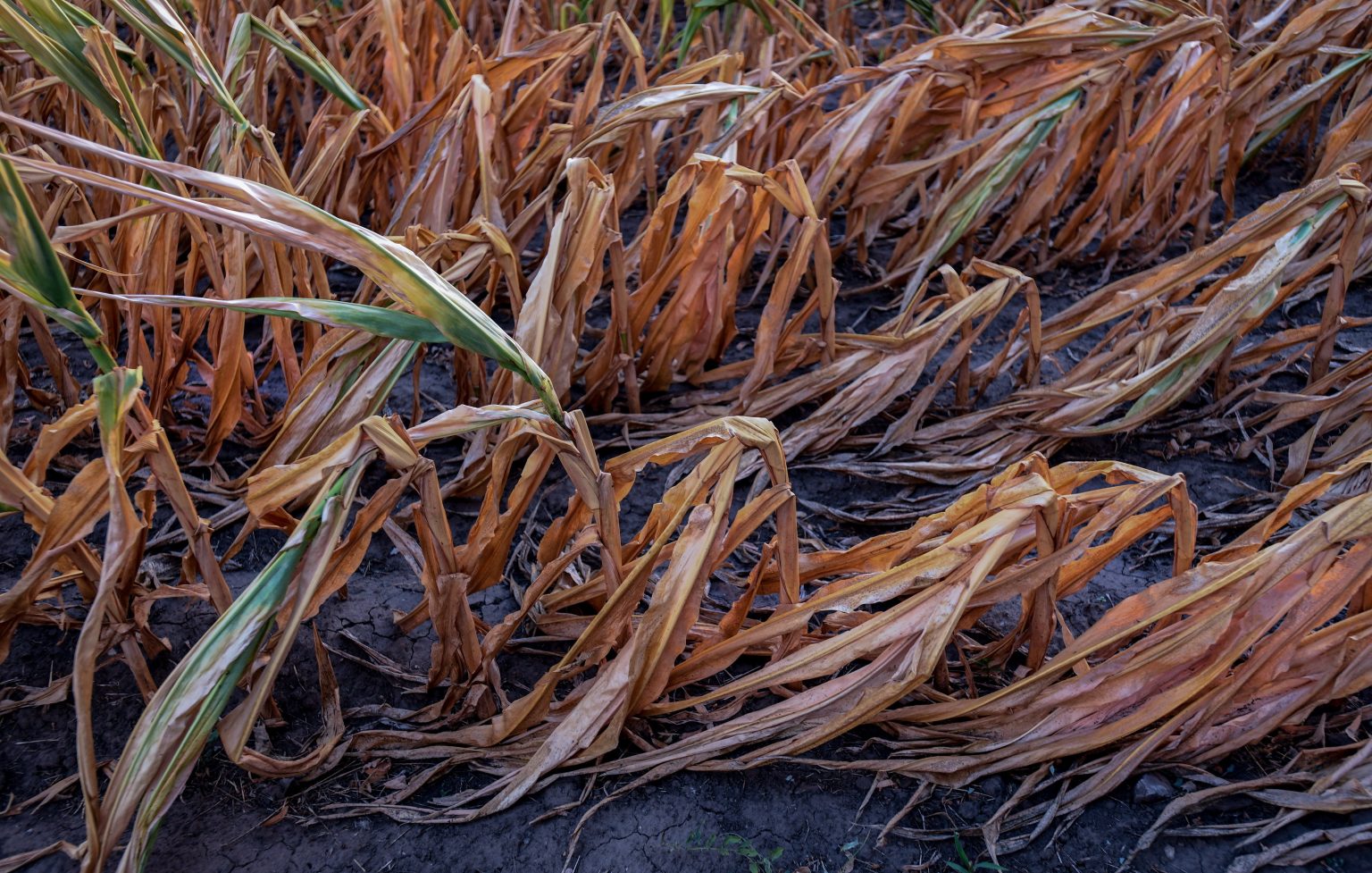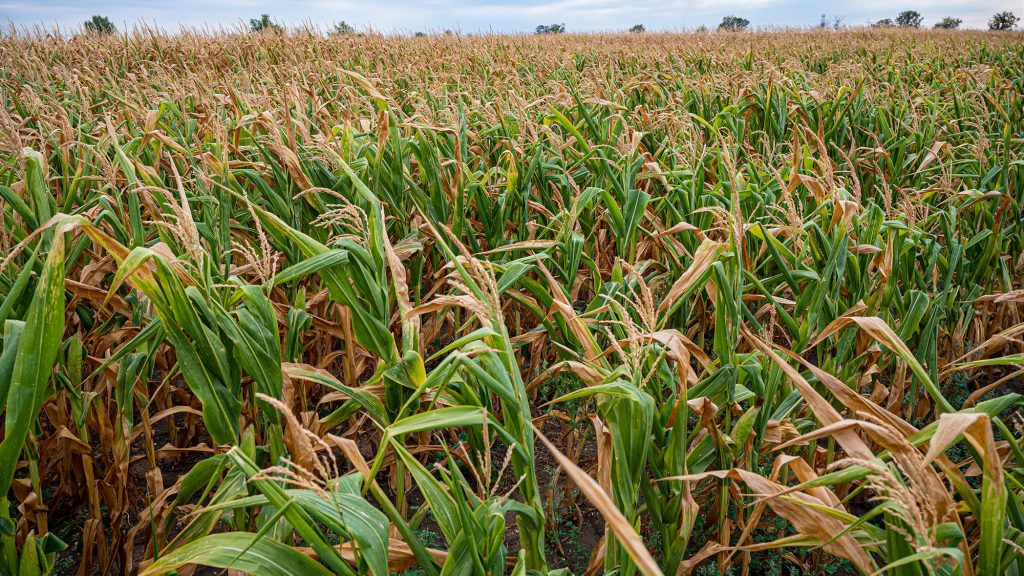Corn crops will suffer greatly if the heat persists for another couple weeks – agricultural economist György Raskó told our newspaper. Last Wednesday, he dedicated a Facebook post to the topic, attaching a picture of corn crops bordering Mezőföld:
Today, the corn is still in such good condition. At 1 PM, it was 38 degrees (Celsius) here, with a humid heat between the rows that corn can easily endure as long as its roots still reach moisture. Unfortunately, signs of heat stress will be apparent here as well in 3-4 days. We can forget about an excellent crop, but a good medium yield is still possible.
Replying to our question, he explained that the situation has somewhat worsened since then, and it continues to deteriorate. Especially if we consider that we were looking forward to outstanding yields at the end of June due to abundant rain and relatively mild weather. In practice, this resulted in two to three rich cobs per plant. But now, the extreme heat is hard on the plants, slowing their metabolism and leading to so-called heat stress, which means we can expect two or just one cob per plant instead of three.
Moreover, late-planted corn varieties are still in the flowering stage, but pollination becomes impossible due to the weather, as the pollen simply burns in the heat. The lack of precipitation is also a serious problem, especially in the Danube-Tisza Interfluve region, where soil water levels have already dropped below the root zone. Irrigation can help to some extent, but the only real solution would be substantial rainfall and a few degrees of sustained cooling.

Every day counts
The hope for an outstanding yield is therefore gone by now, and this is also true for sunflowers. Even if the situation doesn’t worsen further – meaning we don’t get new consecutive heatwaves – we still have to say goodbye to optimistic expectations: for instance, the yield could decrease by
- 20% in the Little Hungarian Plain (Kisalföld) region,
- 50% in the Danube-Tisza Interfluve (Duna-Tisza Köze) region,
- and by 30-40% in the Transtisza (Tiszántúl) area.
According to the expert, this doesn’t translate to a corn shortage, but it does mean that the crop will become more expensive on the domestic market. Although corn could be imported from Ukraine to „regulate” domestic prices, Raskó believes it is unlikely that the government will lift the existing ban on grain imports. Thus, due to the smaller yields, the production costs of ethanol, isoglucose, and animal feed will increase.
We also asked agricultural professor Csaba Gyuricza, rector of the Hungarian University of Agriculture and Life Sciences, about the outlook. In his assessment, the hot and dry weather is causing the national average yield per hectare to decrease by about one ton per week. It is already certain that agriculture will register losses in both corn and sunflower production – the only question is how large these losses will be. Weather forecasts currently predict short and relatively mild relief, but there is no end in sight to the hot and dry period. „But when century-old heat records are broken almost daily for a week, every day counts” – adds the professor. We could arrive at a point when the question is not how much a plant will produce but whether it will survive at all.

Currently, both corn and sunflower are exposed to severe heat stress. Much depends on how much water they can absorb from the soil, which also depends on how deeply they have rooted. Plants that have managed to root deeper can absorb water faster more effectively. Adequate amounts of high quality nutrients in the soil positively affect water utilisation, theoretically allowing such plants to survive high-temperature periods. However, due to the extreme heat, leaf transpiration is so intense that root water absorption cannot keep up. A moisture deficit develops, and the plant begins drying out.
Usually during heatwaves, the moisture deficit that develops during the day balances out at night as temperatures drop significantly. But currently, nighttime temperatures are also so high that the plant has no time to regenerate. And when 38–42 degree days keep recurring, the plant eventually reaches its tolerance limit: „it burns, it fries, it dries out” – the professor puts it.
According to Gyuricza, this is when it becomes clear whether soil cultivation was adequate or not, as that is what determines how much moisture the soil can retain and whether the plant can survive critical periods. If century-old heat records are being broken for such extended periods, not even the most adequate technology will help; the plants will perish. The crop loss will result in serious national economic damage: during the current period, corn alone can account for a roughly rounded loss of 100 billion forints per week. To our inquiry, the professor presented a detailed calculation for these figures.
The weekly loss of one ton per hectare is a very optimistic forecast, and we cultivate corn on nearly one million hectares. (According to the Ministry of Agriculture, this year only on 874 thousand hectares – ed.) The price of corn is currently around 70,000 forints per ton, which amounts to 70 billion forints for the entire arable area. However, since the heat and drought are not over yet, a more realistic estimate would be 100 billion in damages weekly in such record-breaking weather. And that doesn’t even account for sunflowers and other crops awaiting harvest, which are also at great risk.

“Hungary ranks lowest in Europe regarding diversity”
As a reminder: the harvest was so catastrophic in the summer of 2022 that Hungary had to import corn, causing national economic losses exceeding a trillion forints. According to Gyuricza, fortunately, we are not back at this point yet, but it is worth drawing some important conclusions from the current situation even though we are not expecting damages of the scale seen two years ago. One is that even though the first half of the year had many rainy periods, much more of this moisture could have been stored in the soil through proper cultivation, anticipating critical periods. The cornfields that will survive the coming hot weeks will be the ones where this was considered.
However, according to Gyuricza, there is no other European country with such a uniform crop structure for arable plants. On 75-80 per cent of the country, there are only four plant cultures in production:
- corn,
- winter wheat,
- sunflower,
- and rapeseed.
This accounts for about 3 million hectares out of the 4.2 million hectares of arable land. This monoculture mindset poses a significant threat to Hungarian agriculture, which could be mitigated by diversifying the crop structure and making agriculture more varied. In Europe, Hungary is performing the worst in this regard. In the areas most affected by drought, the area planted with corn and other drought-sensitive crops should be drastically reduced, and drought-tolerant crops such as sorghum or millet should be introduced.
According to the rector, it seems that the catastrophic drought of 2022 was still not shocking enough for the stakeholders of the agriculture sector, as they continue to look for emergency solutions rather than trying to prevent damage.

In Hungary, a yield of 7-8 tons per hectare for corn is considered an outstanding result. According to Gyuricza, much larger amounts could be harvested if more attention was paid to
- irrigation development,
- soil-conserving and moisture-saving soil use,
- the correct choice of seeds,
- and harmonious nutrient supply.
Hungarian arable land has much greater potential, and it would be possible to achieve a yield of 10 tons per hectare for corn. In favourable years, the country can still produce twice the domestic demand for wheat, corn, and sunflower. This means there could be plenty to export, but in Gyuricza’s view, Hungary’s best economic interest would be to develop the full processing capacity domestically and export processed products, so that not a single grain of wheat or corn leaves the country unprocessed.
At the same time, it would already be good if a yield security of 7-8 tons could be expected consistently
– says the rector. However, this summer once again leaves us with no choice but to anxiously watch the weather and try to save whatever can be saved.
(An earlier detailed interview with Csaba Gyuricza outlines how Hungarian agriculture could successfully face the challenges of climate change.)




